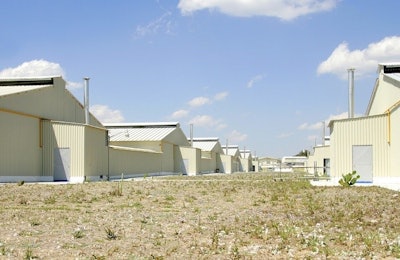
Five years have passed since the major avian influenza outbreaks that originated in 2012 in Jalisco, and the H5N2 and H7N3 strains of avian influenza are endemic to the country. There seems to be no way out of the problem.
Why is this? During an interview at the International Egg Commission (IEC) conference in Monte Carlo, Monaco, IEC President César de Anda said he believes vaccinating was not a bad decision, because it was the only option available at that time.
In contrast to Mexico, the U.S. culled 40 million birds, at a cost of more than $1 billion.
“I wish we could have done the same, but it was impossible, because there were almost 100 million birds in the central part of the country,” de Anda said. “Literally, Mexico would have run out of eggs."
Why there has been no progress?
One theory is that egg producers felt comfortable, because the vaccine more or less worked. In spite of the enormous cost and the management problem, the issue was controlled.
But if the virus mutates, then “it is a tremendous waste that means a huge degradation for the country,” de Anda said. “If Mexico had a sanitary qualification – say, like a Standard & Poor's rating – we would have been lowered in health status by several degrees.”
Mexico should set a good example in the health aspect. The problem is there; poultry farmers live with it, controlled by vaccination.

César de Anda, Mexican egg entrepreneur and president of the IEC, says Mexico's poultry industry seeks to reinvent itself, although he wishes it were moving faster. | Benjamín Ruiz
Relocation of the egg industry
“The Mexican poultry industry has sought to reinvent itself,” de Anda said, "but I wish it would have been much faster."
He said, "at that time, the Secretary of Agriculture, Francisco Mayorga, opened the doors to us to find a faster way out to the avian flu problem; it was a national security issue. In those meetings, he emphasized the need to relocate the national poultry industry, decentralizing it from production areas such as the states of Jalisco and Puebla." The idea was to build facilities in open areas that, at that time, were not populated with hens or chickens.
Unfortunately, Mexico's poultry industry has been slow in that decision-making process "and that has cost a lot of money."
Some companies made the decision to invest outside their regular production areas and have gradually decentralized.
“Maybe five years late, but it has been done little by little. I think in another five years, the difference will start to be noticed in Mexico,” de Anda said.
The egg industry is moving to central Mexico, to states like San Luis Potosí, or to the north, in the state of Chihuahua. It has also migrated to the southeast, to the states of Campeche and Tabasco, areas that are traditionally not involved in poultry production. This indicates that, in 10 or 20 years, Mexico’s poultry industry will change its distribution and, above all, will be decentralized.
Poultry production is easy in Mexico
Mexico is traditionally strong in poultry production. It has achieved the rank of the fourth largest chicken producer in the world and is the world’s sixth largest egg producer.
There are very competitive, high-tech businesses with state-of-the-art facilities, but there are also facilities with 30- or 40-year-old infrastructure.
“It's relatively easy to do poultry in Mexico," de Anda said. “There is every facility for supply, integration, including even more than in some areas of the United States."
Loss of competitiveness
Producing poultry might be easy in Mexico, but it stumbles over the health problem of avian flu. Jalisco has lost competitiveness and, as de Anda said, “it is destined to renew itself or die.” If Jalisco, the largest poultry-producing state in Mexico, does not evolve -- if the facilities of its poultry companies are not relocated and return to the productivity standards they had before -- the state will face very difficult times ahead.
de Anda said he believes the industry and the government have to “commit to make a 10-year plan, in which we will place poultry at the same level of competitiveness as before.” Today, Mexico does not have it, while other countries do. The plan should look beyond the borders.
Export as an objective
Mexico is not only important because of its production volume or its rate of consumption of eggs and chicken meat. Its geographical location also makes it very competitive. But what has happened to its exports?
Mexico should dedicate itself to exporting. Of course, facing the Pandora's box opened by the U.S. government and the unknown future of the North American Free Trade Agreement (NAFTA), the prospect is uncertain.
In the NAFTA negotiations that may take place, “Mexico must take advantage of the opportunity to insist on its products entering the United States,” de Anda said. If the U.S. wants to renegotiate – after 20 years in which Mexico has not been able to export poultry products – it must agree, with all the elements and fundamentals, that Mexican chicken, eggs and egg products enter the U.S. market.
Although the mechanisms of understanding that the Mexican poultry industry has with the U.S. are good and have worked to resolve controversies, it also implies responsibility on the part of Mexican industry and authorities.
It will require the joint work of the National Poultry Producers Association (UNA) and its members, the companies interested in exporting, and the Mexican government’s agricultural administrations (Senasica and Sagarpa) for Mexico to take advantage of these negotiations.
De Anda, also an entrepreneur, said he believes that, for the time being, they must concentrate on the most important market for Mexico: the U.S. Then, they can think about Europe or the Middle East. “Our company has exported to Japan for 20 years, but if we could export to the United States it would be different."
Following the example of other Mexican agricultural products
“In poultry, we have to follow examples that have been successful," de Anda said. There are products that lead the way on poultry, such as pork exported to Japan, or the praiseworthy work of Mexican producers of avocados, tequila and beer that are exported worldwide.
de Anda estimates Mexican poultry is worth more than $10 billion, because of the value added. By not exporting at least 10 percent of that value, "then it is not a prepared industry, and even if we say that we are a competitive industry -- a leader in the world, an example in consumption, good productivity, leading companies, extraordinary marketing, novel advertising in the streets – we are not complete. "
Mexico needs to have a long-term state policy to promote agricultural products.
Is Mexican egg consumption approaching its limit?
With consumption of a bit more than one egg a day per Mexican per year, de Anda says that for many years the sector has wondered how far consumption could increase. And when it is believed that the limit has been reached, consumption grows again.
Consumption hasn’t grown substantially for some time. However, de Anda said, “I am optimistic that it will go further. One of these days, we will be surprised to see that we have reached 400 eggs per person per year."
But, how? Through a variety of offerings, with different presentations and egg products. Not with the same old product.
















